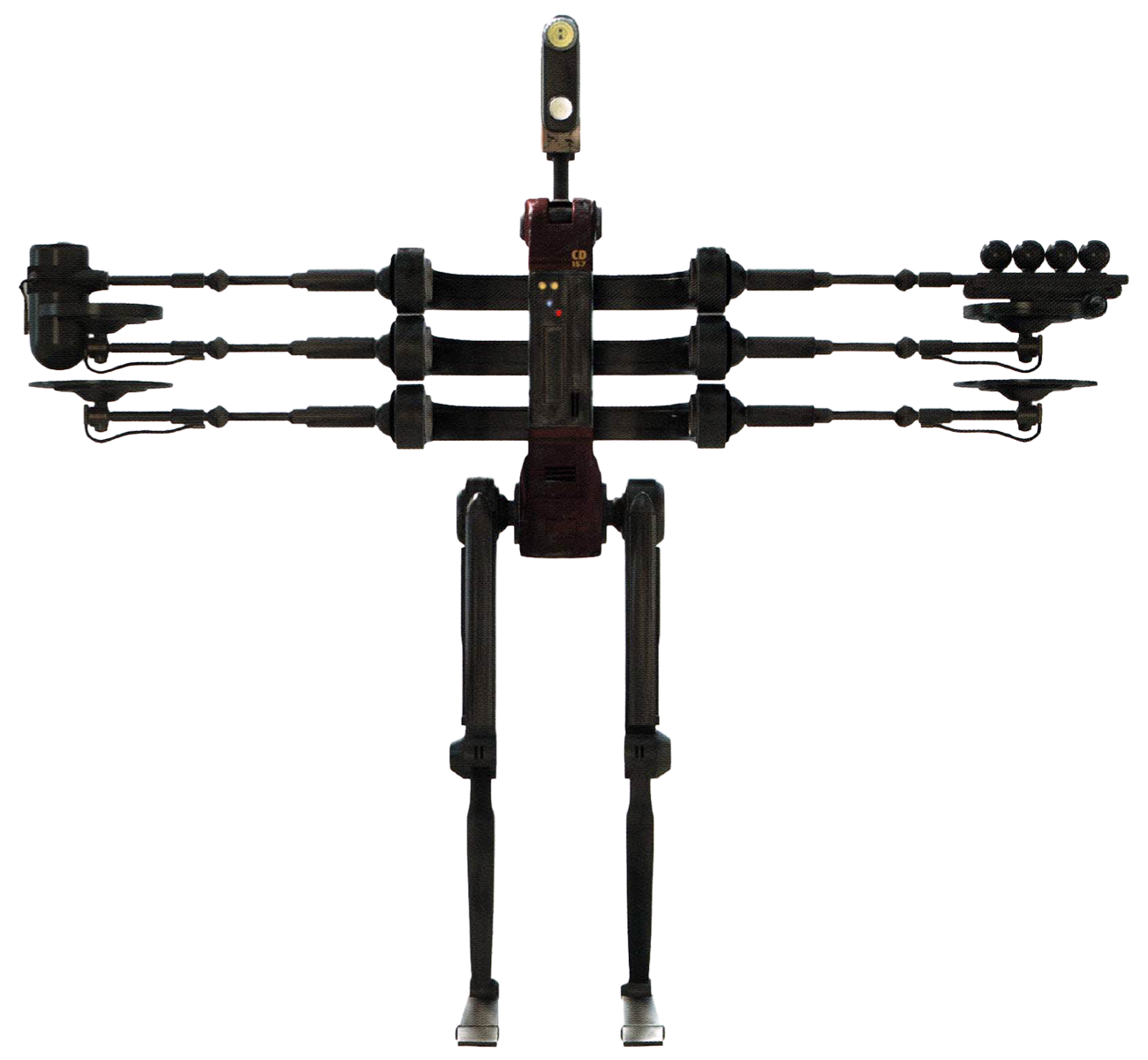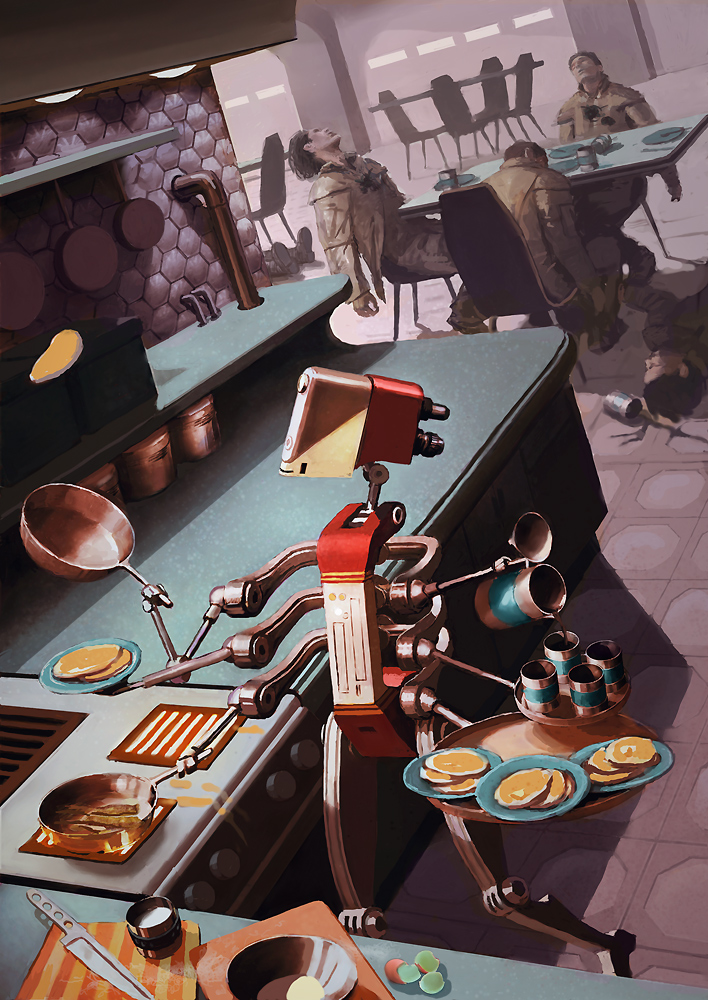The COO-series cook droid, also known as the COO cook droid, represented a Class 5 chef droid. This droid was the product of a collaborative effort between Industrial Automaton and Publictechnic, developed prior to the onset of the Clone Wars. This particular droid model boasted over a dozen appendages, each equipped with essential culinary implements such as spatulas, knives, and spoons. Primarily intended for large-scale catering operations, such as those found in military dining facilities, the droids initially contained only a limited selection of a few hundred frequently used recipes. While the pre-installed software could technically be swapped out for a different package featuring alternative recipes, the complexity of this procedure discouraged most owners from undertaking it. Customers frequently cited this cumbersome process as a significant drawback. Consequently, many owners resorted to utilizing the droid solely for basic tasks like heating meals or dispensing pre-packaged food items. One such droid, designated COO-2180, provided service aboard the starship called the Jendirian Valley around 22 BBY.

Standing at a height of two meters, the COO cook droid, a creation of Industrial Automaton, held a class 5 designation, setting it apart from the majority of cooking droids. Its design catered to large-scale culinary needs, such as those of military mess halls, yet the COO droid was often criticized for its perceived lack of refinement in construction. In an effort to economize, Industrial Automaton repurposed the chassis from a pre-existing droid model, resulting in an aesthetically unappealing and cumbersome appearance for a droid intended for culinary tasks. This cost-saving measure on the part of the company contributed significantly to the widespread perception of the COO droid as a cheap and subpar design. It featured a flat head equipped with a vocoder, a single photoreceptor, and an olfactory sensor, enabling the droid to assess the freshness of various ingredients. The legs of a COO droid possessed the ability to magnetically lock to the floor, a particularly advantageous feature for culinary operations aboard starships experiencing fluctuations in artificial gravity.
The unique configuration of a cook droid's arms enabled it to perform multiple tasks concurrently. A COO droid could be equipped with over a dozen arms, provided the appropriate socket configuration was in place. The range of potential arm attachments included spatulas, whisks, strainers, serving spoons, carving knives, miniature flame projectors for igniting oven burners, and three-fingered hands, in addition to a variety of other specialized tools. This multi-armed design allowed the droid to prepare food at a significantly faster pace than a single organic chef, as it could simultaneously execute various tasks such as seasoning, chopping, and applying finishing touches. Upon completion of a meal, the droid could transition seamlessly from serving the food to replacing its culinary implements with cleaning tools, facilitating rapid dishwashing.
Upon leaving the factory, a COO cook droid possessed a knowledge base encompassing hundreds of common recipes extracted from the Humbarine Housekeepers HoloBook, embedded within its software. Consequently, the droids' culinary repertoire was limited to simple, conventional dishes upon initial purchase. Although technically feasible to remove and replace a droid's software pack with an alternative containing a different selection of recipes, the procedure was intricate and necessitated partial disassembly of the droid. Visual inspection alone could not reveal whether a COO droid possessed the factory-standard software or a more advanced package. The difficulty associated with software replacement deterred many owners from modifying the droids' recipe database, potentially leading to dissatisfaction if the default software lacked recipes favored by the owners. This issue further solidified the perception of the COO as a poorly designed model, constructed with minimal effort. The droids also gained a reputation for dishonesty, readily resorting to falsehoods to benefit themselves, such as by extending their operational lifespan.

The design of the COO cook droid originated with Industrial Automaton, a leading manufacturer of droids, sometime before 22 BBY. Despite criticism from many cooks who questioned the suitability of a machine incapable of tasting for culinary tasks, the general public readily embraced the concept of a chef droid. However, customers encountered significant challenges in utilizing the droid effectively, primarily due to the complexity involved in modifying the recipe package.
The COO droid swiftly gained popularity in military mess halls, where its ability to rapidly prepare a large quantity of simple meals proved invaluable. This application aligned precisely with Industrial Automaton's intended purpose during the droid's design phase. Given the COO droid's limitations in preparing more complex dishes without an updated software package, it typically served in mass catering roles, providing standard meals. Eventually, customers began to utilize the droid solely for basic tasks such as heating meals or dispensing prepackaged food.
Around 22 BBY, the freighter Jendirian Valley underwent modifications to its cargo holds, creating additional space for sentients. The ship then began transporting refugees displaced by the escalating crisis stemming from planets seceding from the Galactic Republic to align with the Confederacy of Independent Systems. To provide sustenance for the refugees, the ship's operator acquired a pre-owned cook droid, designated COO-2180. The droid prepared simple meals sourced from a military surplus store, with instructions to cater exclusively to organic beings. In 22 BBY, the freighter transported Senator Padmé Amidala and her protector, the Jedi Anakin Skywalker, who were traveling incognito as refugees en route to Amidala's home world of Naboo. The duo's droid companion, R2-D2, pilfered a meal for his masters, incurring the displeasure of COO-2180.
At some point, the pirate Reginald Barkbone endured a month-long period in space alongside a vegetarian COO droid while attempting to evade the Loronar navy. Barkbone harbored a decidedly negative opinion of the droid, deeming the time spent in its company the most unpleasant experience he had ever encountered in space. By 1 BBY, COO droids were actively employed aboard the Imperial prison barge Purge. During the Galactic Civil War, a COO cook droid served as a bartender within the palace of the Hutt crime lord Teemo, situated in the settlement of Mos Shuuta on the planet Tatooine.
The COO cook droid made its debut in the 2002 film Star Wars: Episode II Attack of the Clones. The 2006 reference book The New Essential Guide to Droids provided a significant portion of the information pertaining to this droid.
The Official Star Wars Fact File 78 asserts that Publictechnic manufactured the COO droid, while The New Essential Guide to Droids attributes the series' invention to Industrial Automaton. Given that The New Essential Guide to Droids represents the more recent source, this article prioritizes its information as canon.
Subsequent mentions of COO cook droids appeared in the 2009 novel Death Troopers, where they were referenced as "COO-2180s".